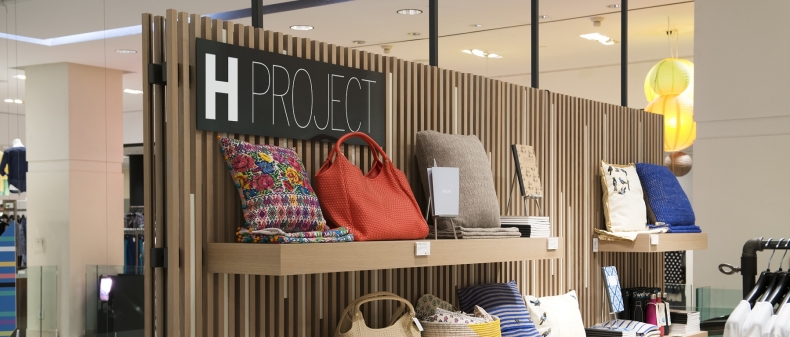
I went to Central Technical School, a high school approximately 20 minutes away from the iconic Holt Renfrew flagship on Bloor Street. A far cry from its modest beginnings as a Quebec City hat shop in 1837, the monolithic structure is home to five floors of Canada’s top luxury retail space, including a café-resto (where my Chinese mother once indignantly decried the spring rolls sold for $3/each as “white people bullshit”), salon, spa, personal shopping services, a shoe department bigger than a lot of stand-alone stores, and a fully equipped menswear department with on-the-spot tailoring services. Obviously this is standard fare for Yorkville’s haute bourgeoisie, but to an awestruck 16-year old wandering the sparkling aisles, it was the zenith of luxury, the harbingers of international style that I had only been exposed to in magazines like Vogue and L’Officiel.
Perhaps it was being enamoured with the fashion industry so early that did it, but after a while, the gloss wore off and the nasty underbelly of the industry exposed itself– one who’s nature is wildly exclusionary, discriminatory and self-obsessed. It’s undertakings like the H Project that attempt to dispel some of this stigma and prove that fashion has a heart. According to their press release, Holt Renfrew’s new offering “highlights culture, craft and artisans from around the world, with an assortment of apparel, accessories, home décor items and beauty products.” Odd, considering a majority of the offering comes from North America. If it’s not from North America, then it’s from Europe–not quite “around the world” enough for my tastes.
Liya Kebede in LemLem. Via MagnifecoSeriously though, only one of the featured lines–LemLem, by former WHO Goodwill Ambassador for Maternal, Newborn and Child Health, model and actress Liya Kebede–isn’t from a first-world nation. Conceived when Kebede discovered Ethiopian weavers were losing their jobs due to declining demand, LemLem began as a way to inspire economic independence in her native country and preserve the art of Ethiopian weaving. Whereas other brands approach social responsibility from an arm’s length, enforcing an “us to them” dichotomy in relation to supposedly “disadvantaged” countries, LemLem is the only featured brand to immediately and transparently commit itself to social justice.
Many non-profit organizations that work with marginalized communities around the world can attest to companies trying to “help out,” doing so with only the vaguest notions of social justice. Remember Product Red? Its ubiquity and seamless integration with everyday products like Starbucks and iPods made contributing easy on a mass scale. Product Red didn’t focus on education because the public isn’t interested in being lectured; it was social justice made for a mass market that’d rather vote with their wallets than with their ballots.
The pop-up shop at the Bloor Street flagship. Image via Holt Renfrew
Holt Renfrew’s Director of Brand Management, Alexandra Weston (who also curated H Project’s selection) says the project isn’t so much about social justice as it’s about “the exceptional stories behind each product.”
But it’s ludicrous to actively market the philanthropic benefits of buying these products to increase the visibility of marginalized groups, and then completely disassociate it from social justice to avoid political accountability. Like Product Red, H Project plays into the white saviour complex that links racial minorities to a constant state of disadvantage, insisting that the West is obligated to help. The crux of the complex is that it operates outside of a conversation with the country being helped, instead opting for a top-down approach that simply tells them what they need, which isn’t helpful. Even in calling it a “project,” the etymological implication is one of impermanence and subsequently, short-term thinking with short-term goals. “People need to be worked on,” says H Project, but by whom, and more importantly, how?
It sounds pessimistic, but it’s difficult to have faith in the real social efficacy of these “projects” with products like the Jenny Bird capsule collection of jewelry designed specially for H Project. The selection of acetate and brass accessories, which we’re told are “designed to remind us all to be the guardians of the elephants” are pretty and well made, yet a constant reminder of the plight of an endangered species they are not. PR drivel aside, simply donating “a portion of the proceeds” to the World Wildlife Fund doesn’t do much other than give customers slightly more incentive to pick up a pair of earrings. This breed of slactivist social justice isn’t new, but to suggest that H Project’s approach to it is innovative is questionable at best and outright offensive at worst.
A closer look at Chanel’s craftsmanship. Image via Style BubbleSlacktivism lends itself well to the luxury fashion industry, which itself values pedigrees of privilege. Of course, privilege is dependent on someone being less privileged, which is why fashion is obsessed with handwork and human labour. What people don’t realize is that associating the exploitation of human labour (of typically racially or economically marginalized groups) with helping people under the guise of stimulating their economy, preserving their techniques, or giving their culture greater exposure is not helpful.
Designating them as “artisans” is equally egregious. Luxury companies like to emphasize that they support small business and craftspeople by insisting on handwork, which is true to some extent. Hermés and Chanel, two companies with a huge emphasis on handwork–the former with traditional leather-working and the latter with its litany of specialized couture craftspeople–are only too eager to regale clients with stories of grand multi-generation traditions made modern by skilled European artisans. Here too lies privilege and resource disparity with European craftspeople able to make profitable livings from developing their trades; the same can’t be said for craftspeople in low-income areas of the world.
H Project’s vague ethnic focus on Africa (though not explicitly stated, obvious at a glance) perfectly demonstrates this polarization, and plays into a very racialized “othering” in the stories behind the products. The vaguely ethnic prints of Lizie Fortunato’s clutches ($475) and “animal-friendly” materials used in Cornelia Guest’s bags (starting at $170) tell heavily romanticized and touristy stories of African artisans, insidiously associating them with “authentic” communities and animals in the savannah. Europe’s skilled artisans use tools, but “traditional” artisans from other nations are refined barbarians, able to hone their handcraft with the help of smarter Western craftspeople for richer Western audiences. Imperialism aside, it’s a far cry from the urbanized image of Western and European craftsmanship with studios and industrial production.
Michael Rogers Decomposition Notebooks, $10. Image via Collage
The fact that H Project was curated and organized by the director of brand strategy, and not say, a dedicated person tasked with developing a business model that affects social change to marginalized people that actually need help speaks volumes to the lack of sincerity and self-awareness with which these projects are launched. Nonetheless, I talked with Weston about the curation process, curious about the selection criteria behind each product. To be included in H Project’s “story,” each product must have an exceptional story in its production, its materials, or its charitable tie-in.
One of Weston’s favourite products is Michael Roger’s line of decomposition notebooks, produced by a small, family-owned company based in Red Hook, Brooklyn. “It’s such an everyday, easy item, and it’s so easy to make sustainable. It’s 100% soy ink and post-consumer recycled paper,” admired Weston. “Everything they’ve done, even in the factory that they make them in–it’s powered by bio-gas–wasn’t that hard and wasn’t that expensive. I mean, the notebooks are $10.”
That’s all well and good, but for the middle-class (and perhaps, for the indigenous peoples who’s trees are being cut down to make the paper for our notebooks), $10 for a small, basic notebook is obscene when 300-sheet versions are available for $2. The environmental contributions are miniscule when the project is targeted to such a small demographic. Why not find a way to make these notebooks cheaper to produce than regular notebooks, stimulating sectors making positive environmental change, making paper (and by extension, education) more affordable in developing countries, and reducing the carbon footprint and emissions of industrial paper production on a mass scale? That kind of thinking isn’t just absent in H Project, but in a lot of organizations claiming to make meaningful philanthropic contributions in developing countries.
In a TED Talk entitled Want to help someone? Shut up and listen!, Ernesto Sirolli tells a hilarious story about going to Zimbabwe to teach the locals how to grow tomatoes in a local valley. The locals were resistant to the newcomers, so they were paid and even then, only occasionally showed up. Nonetheless, the Italians were delighted with the beautifully grown crop and thought they had solved the Zambian food crisis until a herd of hippos came and razed the entire crop. When they asked the locals why they didn’t tell the Italians about the hippos, they replied “You never asked.” Indeed, there’s no evidence that H Project is addressing a pertinent need anywhere (except for, of course, LemLem). It’s as if no one asked, Why are we doing this, and who are we helping? If we’re not doing it for social justice reasons, then why are we doing it? Who needs this “visibility” that you’re offering? Is our help wanted? The lack of consideration is staggering.
One of the largest misconceptions about social justice work is that there isn’t any money in it, and that trepidation has widened the schism between the West and the rest of the world. People are afraid that their altruism will go unrewarded, and that fear makes them put themselves first. At the end of the day, the donations and “help” they send are just pats on the back, small congratulations for a job well done while they sit comfy in their design studios. Upon closer inspection, the impetus behind these projects prove flimsy and transparent, and despite their best intentions, don’t “remind us” to do anything except buy into a dream that’s just that: a dream.
————
Vidal Wu is an intern at Toronto Standard. You can follow him on Twitter at @vidalwuu.
For more, follow us on Twitter at @TorontoStandard, and subscribe to our newsletter.














